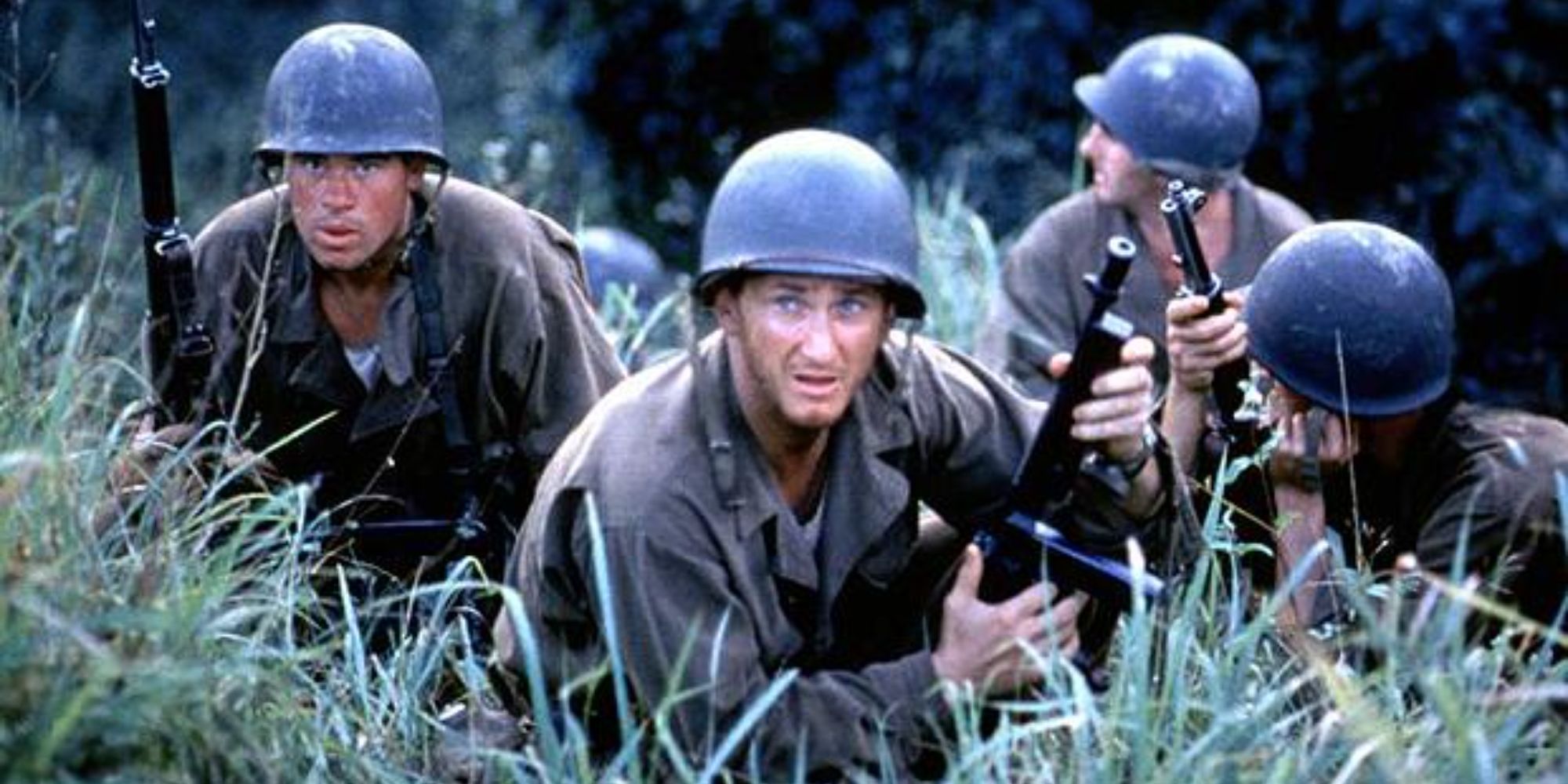There are lot of plenty war movies which shows the real side of war ,War movies have always captured audiences even before the golden era of Hollywood. Starting with Tearing Down the Spanish Flag, which is often named as the first war movie, this type of movie has grown into a cinematic powerhouse. It now creates award-winning masterpieces like Dunkirk and All Quiet on the Western Front. These movies show the harsh and violent truths of war affecting both soldiers and civilians highlighting endurance, unity, and the painful loss of friends in battle.
Even the best war movies cannot capture what people who lived through harsh wars felt. The genre is very market-driven now to make quick money making it tough to know which tales are accurate and which are exaggerated. Taking viewers from their comfy places to the front lines of war, these movies offer the most accurate depictions of war. While some stories may be hard to watch, they remind viewers not to overlook the peace and freedom we have today even though it is not perfect.
1.Apocalypse Now’ (1979)
Directed by Francis Coppola

Image via United Artists
Inspired by Joseph Conrad‘s Heart of Darkness, Apocalypse Now moves the story from Congo to the wild jungles of Vietnam and Cambodia during the Vietnam War. U.S. Army Captain Willard (Martin Sheen) receives a secret order from Colonel Lucas (Harrison Ford): find and kill the enigmatic Green Beret Colonel Walter Kurtz (Marlon Brando), who appears to have gone insane and led his rebel army into Cambodia starting unauthorized strikes against the Viet Cong and the NVA.
Before Apocalypse Now few people recognized the word napalm. However, due to Robert Duvall’s line, “I love the smell of napalm in the morning,” it became linked with the movie. Napalm has a scent in reality; it was often used during the Vietnam War continuing from World War II. Apocalypse Now represents the military equipment, including UH-1 Hueys and a Loach helicopter borrowed from the Filipino army. Yet, some strategies like attacking the village from the air instead of a ground attack stretch realism.
2.‘Letters from Iwo Jima’ (2006)
Directed by Clint Eastwood

Image via Warner Bros.
Based on General Tadamichi Kuribayashi’s Picture Letters from the Commander in Chief and Kumiko Kakehashi’s So Sad to Fall in Battle, Letters from Iwo Jima gives a different point of view of the Battle of Iwo Jima during World War II narrated from the Japanese perspective. Even though small and far, Iwo Jima was a key point between the American forces and the Japanese mainland. If taken by the Americans, it could be a base for attacking Japan. The movie follows the lives of two people: the not typical General Kuribayashi (Ken Watanabe), who was against old methods, and Saigo (Kazunari Ninomiya), a simple baker who did not want to join the army.
The Battle of Iwo Jima took place from February 19 to March 26, 1945. In this battle, the U.S. Marine Corps and Navy took the island from the Imperial Japanese Army. Directed by an American but shown through Japanese perspectives, Letters from Iwo Jima‘s accuracy has minor errors. While its message against war is clear, the behavior and speech of some Japanese characters seem forced. Also, the appearance of kimonos at a time when the Japanese had started wearing Western clothes appears cliched. The movie also lacks an explanation for why the Japanese defended such a small unimportant island making these soldiers seem excessively patriotic and aggressive.
3.‘Master and Commander: The Far Side of the World’ (2003)
Directed by Peter Weir

Set during the Napoleonic Wars, Master and Commander: The Far Side of the World tracks Captain Jack Aubrey (Russell Crowe) on the British ship HMS Surprise. Assigned to intercept the powerful French ship Acheron, Aubrey’s determined spirit and smart strategies lead him across unexpected seas. The battle unfolds near the South American coast moving from rocky Brazilian coasts and past the dangerous Cape Horn to the captivating Galapagos Islands.
The movie is based on Patrick O’Brian’s Aubrey-Maturin series and is set during the Napoleonic Wars from 1803 to 1815. The story and characters are made up but the ship is real. The team did a great job making the HMS Surprise look correct. Master and Commander also shows how the crew behaved even in heavy fighting. Their calmness may seem odd but it was needed to keep order in battle. The film’s action takes place in 1805, not like the book, to keep from showing Americans as the bad guys.
4.‘Downfall’ (2004)
Directed by Oliver Hirschbiegel

Downfall tells the story of the final days of Adolf Hitler’s (Bruno Ganz) leadership from the stories of his last secretary, Traudl Junge (Alexandra Maria Lara). It starts on his 56th birthday on April 20, 1945, and ends with his suicide on April 30. As the Soviet armies close in, Germany collapses. Hitler losing his grip on reality, insists on a German win. He orders his generals to fight to the end even at the cost of Berlin and its 3 million people. This order causes a split in his close group: while some distance themselves from him, others promise to end their lives with him. Overwhelmed by paranoia, Hitler ends his own life.
The movie portrays a unique view of one of the most infamous and despicable people in history. It strives to offer an understanding of Hitler’s thoughts recognizing him as a complex person while still denouncing his terrible and dreadful deeds as they should be. However, Downfall has faced disapproval for humanizing Hitler, with some saying it distorts history to make it more dramatic.
5.‘The Thin Red Line’ (1998)
Directed by Terrence Malick

Based on James Jones‘s autobiographical novel, The Thin Red Line leads viewers to the core of the U.S. Army’s first big World War II attack on Guadalcanal. Soldiers new to war, from a tough sergeant and an eager colonel to a leader unsure of his role, are sent to replace the tired Marines as the U.S. attempts to defeat the Japanese resistance. The fierce fight for an important airfield drives the soldiers of Army rifle company C-for-Charlie to their breaking point.
The Battle of Guadalcanal lasting from August 8, 1942, to February 9, 1943, was a turning point in the Pacific Theater. With excellent sound and visual effects, The Thin Red Line shows the huge pressure on the captains, their prayers to lead, and the harsh sight of vultures flying over the battlefields. Yet, the movie shows Guadalcanal as a very green beautiful place. In fact, the soldiers dealt with a very hot, bug-filled place and always fought against the intense heat.
6.’Das Boot’ (1981)
Directed by Wolfgang Petersen

Image via Neue Constantin Film
Das Boot takes viewers deep into the lives of the German submarine U-96 and its crew during World War II’s Battle of the Atlantic. The crew led by Captain Heinrich Lehmann-Willenbrock, encounters increased threats from Allied destroyers. New crew members like Lt. Wener (Herbert Grönemeyer) get a heavy introduction to life at sea due to the small space and strict rules on the submarine. Even as their situation worsens, the crew maintains its professionalism on difficult missions, although some question the purpose of their service in the war.
Taken from Lothar-Günther Buchheim’s 1973 book, Das Boot truly shows the tight and intense experience of submarine warfare. It highlights how the crew works together to keep U-96 working. While the movie ends with a sad air raid that breaks U-96 when it comes back to port, the real submarine stayed safe until the war ended. However, Das Boot still offers a gripping show of life at sea and secures its spot as one of the best movies of 1981.
7.’Jarhead’ (2005)
Directed by Sam Mendes

Image via Universal Pictures
A study on the mindset of soldiers in war, Jarhead showcases life in the Marines during the Gulf War. It follows Anthony “Sstoff” Swofford (Jake Gyllenhaal), a sniper dealing with dullness, separation, and the challenges of military routines. He joined the Marines in the late 1980s trained as an infantry sniper just as the Gulf War started, and his unit was sent to Saudi Arabia to participate in Desert Shield. Despite waiting 175 days in extreme heat and excitement, Swofford and his group find no combat opportunities, and they are left bored.
A big theme in Jarhead is about waiting. In tales and real life, Marines face the boredom of not knowing. They only move when they get commands from their bosses back home. Jarasshead also shows crazy scenes usual in fighting groups. , it doesn’t give the right background for them. Acts like branding with “USMC” appear as harsh initiations, but they are not common in real life.
8.‘Saving Private Ryan’ (1998)
Directed by Steven Spielberg

Image via DreamWorks Pictures/Paramount Pictures
Saving Private Ryan draws viewers into the chaos of the Normandy Landings on June 6, 1944. Captain Miller (Tom Hanks) and his 2nd Ranger Battalion team have one critical mission: to find Private James Francis Ryan (Matt Damon), whose brothers have died in battle, and ensure his safe return. In the harshness of war, this mission leads them across Nazi-occupied France to meet Ryan’s group, which is part of the 101st Airborne Division.
The movie has received a lot of praise due to its haunting realism in showing how intense the Omaha Beach attack was. Saving Private Ryan has been hailed by veterans for its authentic portrayal of the gritty conditions that soldiers faced. Even with small mistakes like shooting underwater and poor tactical details, the filming weather mirrored how bleak the actual D-Day landings were. The film includes made-up parts like the town of Ramelle but stays honest to the deep connections among soldiers.
9.‘All Quiet on the Western Front’ (1930)
Directed by Lewis Mile;estone

Image via Universal Pictures
All Quiet on the Western Front serves as a strong film against war. It shows young German recruits in World War I. Their teacher full of ideals, pushes them to join the German army with hopes for quick success and honor. But the fierce reality of battle soon destroys their dreams when they face death and severe injury at the harsh Western Front.
Known for its vivid scenes because of no censorship laws, All Quiet on the Western Front shows the harsh reality of war, some scenes come from real war tales told to director Milestone. One scene shows when a soldier caught a piece of barbed wire just before a shell destroyed him. the soldier’s hands were left still holding onto the wire. This harsh truth caused a stir in Germany where the Nazi Party opposed the film for its messages against war and Germany.
10.‘Come and See’ (1985)
Directed by Elem Klimov

Image via Sovexportfilm
Come and See pulls viewers into the harsh realities of World War II from the perspective of a Belarusian boy who joins the Soviet fight against harsh German forces. Each scene shows the severe cruelty of war and its relentless enemies. The boy changes from a naive young person to a tough survivor as seen by his empty eyes shrunken face, and gray hair. There is nothing romantic about fighting — only a loss of innocence.
Written by Kilmov and Ales Adamovich, based on his experiences as a partisan fighter, Come and See faced censorship due to its realistic nature. The film’s authenticity comes from the firsthand experiences of survivors whose painful memories of fascist horrors in Belarus are shown . Inspired by the book I Am from the Fiery Village, which includes direct testimonies from survivors of the harsh fascist genocide in Belarus, the depiction of civilians forced into a church and ultimately killed by soldiers is accurate to these survivor stories.
For more War Movies check on this site -> Top 100 War Movies On imdb







